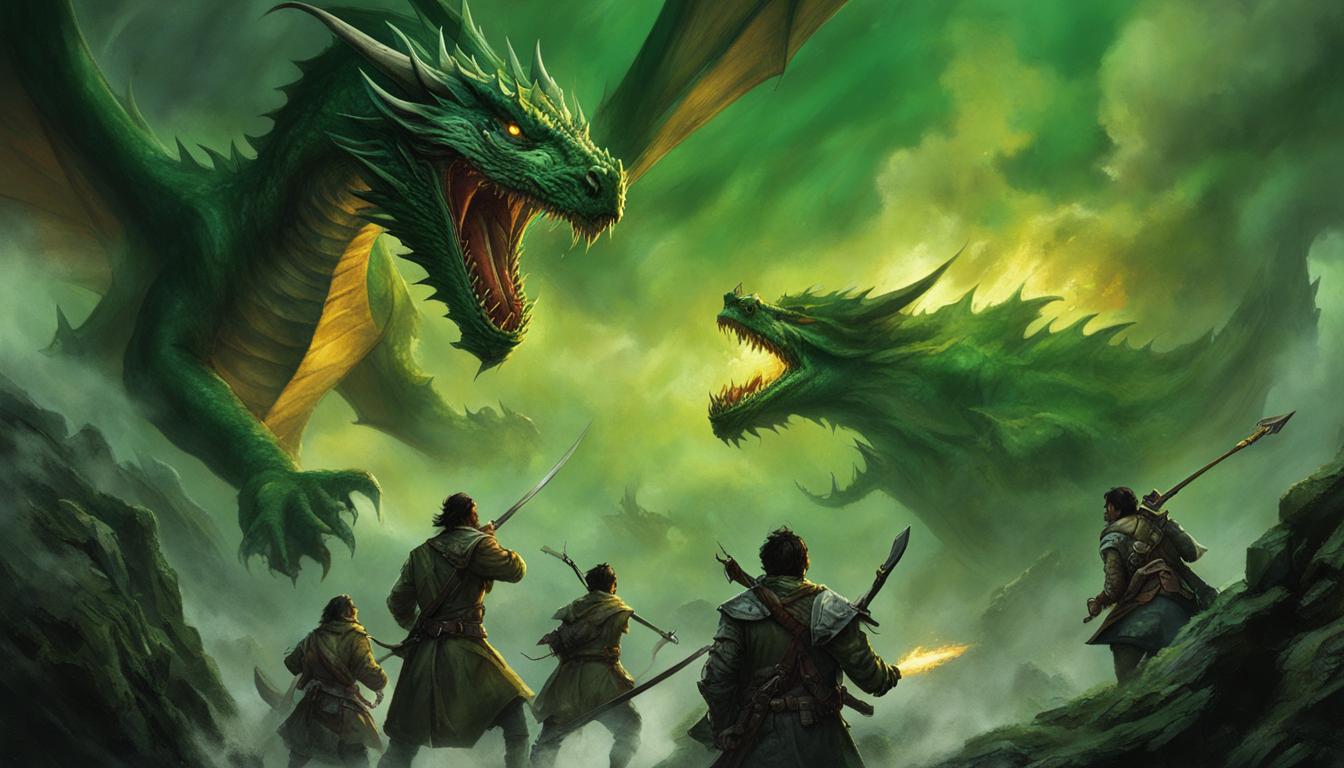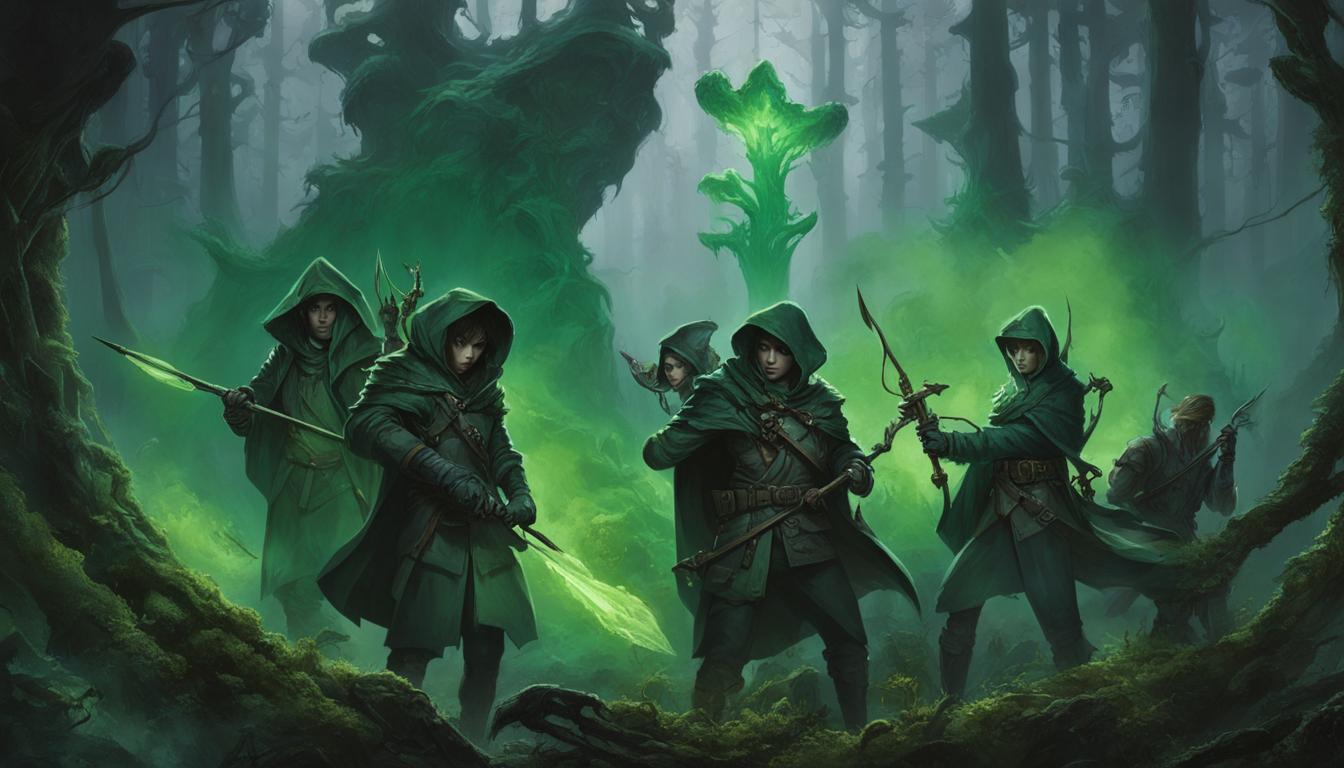DND Poison Damage Guide: Effects & Strategy
Welcome to my guide on DND poison damage! In the realms of Dungeons and Dragons, poison can be a deadly weapon that can tip the scales in your favor during battles. Understanding the mechanics and strategies related to poison damage is essential for any player looking to make the most out of their adventures.
In this guide, we will explore the rules and intricacies of poison damage in DND, as well as its impact on gameplay and narrative. Whether you are a seasoned player or new to the world of DND, this guide will provide valuable insights and tips to enhance your gaming experience.
So, grab your dice and get ready to delve into the fascinating world of DND poison damage!

Key Takeaways:
- Understanding the rules and mechanics of poison damage in DND 5e
- The significance of the Poisoner Feat and its impact on gameplay
- Challenges faced by players using poison in Dungeons and Dragons
- Strategies for strategically incorporating poison into combat
- The role of poisons in the narrative of Dungeons and Dragons
Understanding DND Poison Damage Mechanics
In Dungeons and Dragons, poison damage is a unique and strategic element of gameplay that can have a significant impact on combat and role-playing scenarios. To fully grasp the mechanics and intricacies of poison damage, it is essential to understand how it works within the game.
First and foremost, let’s explore the various types of poison and their effects. In DND 5e, there are different poisons, ranging from basic toxins to potent venoms. These poisons can be applied to weapons, used as traps, or delivered through spells or abilities. Each type of poison has its own specific effects, including damage over time, impaired movement, or temporary ability score reductions.
One important aspect of poison damage mechanics is the Poisoner Feat. This feat provides characters with enhanced proficiency in handling and applying poisons. It allows for more effective use of poison, granting bonuses to damage rolls and saving throws related to poison. The Poisoner Feat can be a game-changer for characters specializing in poison-based combat strategies.
The Poisoner Feat and Its Impact on Gameplay
The Poisoner Feat not only enhances a character’s ability to deal poison damage, but it also opens up new opportunities for gameplay tactics. Characters with this feat can strategically incorporate poisons into their combat strategies, using them to exploit enemy vulnerabilities or gain an advantage in battle.
The Poisoner Feat allows characters to create poisons more efficiently, granting them the ability to craft potent toxins or even extract valuable venom from defeated creatures. This adds an exciting dimension to gameplay, as characters can harvest and utilize poisons as a valuable resource.
Furthermore, the Poisoner Feat enables characters to resist certain types of poison or even become immune to their effects. This can be a vital defensive measure when facing opponents who employ poison as a primary weapon or tactic.
Challenges Faced by Players Using Poison in DND 5e
While poison damage can be a potent tool in the hands of skilled players, it also comes with its own set of challenges. One of the main difficulties players may face is the prevalence of monsters and creatures with resistance or immunity to poison damage. This can limit the effectiveness of poison-based tactics and require players to adapt their strategies accordingly.
Another challenge is the availability and accessibility of poisons within the game world. Finding or purchasing potent poisons can sometimes be a challenging task, requiring players to explore, trade, or interact with specific NPCs or factions. This scarcity adds an additional layer of complexity to incorporating poison damage into gameplay.
Additionally, players must be mindful of potential moral or ethical implications when using poison in their adventures. Depending on the campaign setting and the nature of the characters, employing poison as a weapon or tool may have consequences on their alignment, reputation, or relationships within the game world.
Understanding the mechanics of DND poison damage is crucial for players looking to leverage this element of gameplay effectively. With knowledge of the various types of poison, the impact of the Poisoner Feat, and the challenges involved, players can navigate the world of poisons in DND 5e with skill and strategy.
Strategically Incorporating Poison into Combat
In the world of Dungeons and Dragons, poison can be a powerful tool in combat. When used strategically, it can not only deal damage to enemies but also incapacitate or weaken them. In this section, we will explore strategies for incorporating poison into combat and maximizing its effectiveness.
One key tactic for using poison damage in DND is to target vulnerable enemies. Some creatures may have weaknesses or vulnerabilities to poison, making them more susceptible to its effects. By identifying and targeting these enemies, you can significantly increase the impact of your poison attacks.
Another effective strategy is to combine poison with other abilities or spells. For example, a rogue with the Poisoner Feat can apply additional poison damage to their attacks. By utilizing this feat and coordinating with spellcasters or other party members, you can create devastating combinations that capitalize on the weaknesses of your foes.

Incorporating poison into combat requires careful planning and consideration. It’s important to assess the situation and determine when it’s most advantageous to employ poison. Additionally, coordinating with your party members and communicating your intentions can lead to even more effective strategies.
In the next section, we will explore the role of poisons in the narrative of Dungeons and Dragons, shedding light on their storytelling significance and the role-playing aspects of harvesting and crafting poisons within the game.
The Role of Poisons in Dungeons and Dragons Narrative
In the world of Dungeons and Dragons, poisons play a significant role in shaping the narrative and adding depth to character development. From lethal toxins to debilitating substances, various types of poisons provide unique opportunities for storytellers and players alike.
Types of Poison and Their Narrative Importance
There is a wide array of poisons in the DND narrative, each with its distinct properties and effects. Whether it’s a venomous serpent’s bite that paralyzes its victims or a deadly concoction that slowly eats away at the target’s vitality, poisons bring danger and suspense to the story.
These deadly substances often serve as tools for characters seeking to gain an advantage, extract information, or eliminate adversaries discreetly. The narrative importance of poisons lies in their ability to introduce unforeseen twists, test the hero’s morality, and set the stage for thrilling encounters.
Such narrative moments not only create tension and suspense but also provide opportunities for characters to make difficult choices that define their paths and shape the overall plot.
Harvesting and Crafting Poisons: A Role-Playing Perspective
One aspect of poisons in DND that adds depth to the role-playing experience is the ability to harvest and craft these deadly substances. Characters with proficiency in alchemy or herbalism can collect poisonous ingredients from exotic creatures or dangerous plants found throughout the world.
By investing time and resources, characters can experiment with different recipes, creating potent toxins tailored to their needs. This process not only enhances immersion but also adds a layer of strategy and customization to the gameplay. Crafted poisons can be used strategically in combat, as bargaining tools, or combined with other skills or items to create unique effects.
Additionally, the act of harvesting and crafting poisons can initiate memorable role-playing interactions, allowing characters to showcase their expertise or collaborate with knowledgeable NPCs. These moments of discovery and experimentation further enrich the narrative and deepen the connection between players and their characters.
| Poison Type | Effects | Source |
|---|---|---|
| Wyvern’s Venom | Causes paralysis and intense pain | Harvested from defeated wyverns |
| Deathcap Toxin | Induces hallucinations and rapid deterioration of the mind | Extracted from rare deathcap mushrooms |
| Black Widow’s Bite | Causes necrotic damage and potential death | Procured from black widow spiders |
Table shows a few examples of different poisons that can be found in the world of DND and their effects. Each poison brings its unique challenges and potential rewards, further enriching the storytelling experience.
Maximizing the DND Poison Damage in Your Campaign
When it comes to enhancing your Dungeons and Dragons (DND) campaign, poison damage can be a powerful tool in your arsenal. Whether you are a player looking to optimize your character’s abilities or a dungeon master seeking to create memorable encounters, maximizing the use of poison damage can add depth and excitement to your game. In this section, I will provide you with tips and strategies to effectively utilize poison damage in your DND campaign.
1. Creating Poison-based Characters:
One way to maximize poison damage is to create a character centered around poison abilities. Classes like the Rogue (Assassin archetype) and the Druid (Circle of the Spore) have access to poison-related features and spells that can significantly increase the efficacy of poison in combat. Focus on abilities that enhance poison damage, such as the Rogue’s Poisoner’s Kit proficiency or the Druid’s Halo of Spores.
2. Utilizing Poison in Encounters:
As a dungeon master, you can create encounters that highlight the effectiveness of poison damage. Consider introducing enemies vulnerable to poison or ones that are weak against poison-based attacks. Additionally, you can incorporate environmental hazards, like poisonous swamps or venomous creatures, to provide opportunities for players to exploit poison damage.
3. Combination Tactics:
Maximizing poison damage often involves combining it with other abilities or spells. For example, a character with the Poison Spray cantrip can further enhance their damage output by applying crowd-control effects like the Grasping Vine spell or entangling enemies in an area of effect. Take advantage of synergy between poison and other elements to maximize your campaign’s poison damage potential.
4. Creative Role-playing Moments:
Poison damage can create memorable and impactful moments in your DND campaign. Incorporate poison in puzzles, traps, or as a narrative plot element. For instance, a poisoned NPC could offer valuable information in exchange for an antidote, leading to an intriguing quest. These role-playing opportunities not only enhance the story but also showcase the versatility and strategic use of poison damage.
By implementing these tips and strategies, you can elevate your DND campaign by maximizing the use of poison damage. Whether you are a player or a dungeon master, the effective use of poison can add excitement, complexity, and strategic depth to your game.

Understanding Poison Resistance and Immunity Among Monsters
In the world of Dungeons and Dragons, encountering creatures with resistance or immunity to poison damage is not uncommon. Understanding the mechanics of poison resistance and immunity is crucial for safeguarding your party and effectively strategizing against these formidable foes.
How to Overcome Poison Damage Resistance and Immunity
While facing monsters with poison resistance or immunity may initially seem daunting, there are methods to overcome these challenges and still deal significant damage. Here are a few strategies:

- Exploit Vulnerabilities: Some creatures may still have weaknesses to certain types of poison. By identifying and utilizing these vulnerabilities, you can maximize your party’s damage output.
- Access Alternative Damage Types: If poison damage proves ineffective, consider switching to other damage types that the creature is not resistant or immune to. This can help you bypass their defenses and maintain your offensive capabilities.
- Use Magic and Abilities: Spells or abilities that mitigate or bypass resistance and immunity can be invaluable against poison-resistant creatures. Look for spells or abilities that specifically mention overcoming resistances or immunities, such as “Protection from Poison” or “Elemental Weapon.”
- Employ Crowd Control: Utilize crowd control tactics to neutralize the threat posed by poison-resistant or immune creatures. Restraining, stunning, or incapacitating them can give your party the upper hand in combat.
- Enhance Poison Effects: Explore options to enhance the potency of your poisons or inflict stronger secondary effects. This can be achieved through item enchantments, alchemical mixtures, or class features like the Assassin subclass. By employing these strategies and thinking creatively, you can overcome the challenges presented by poison resistance and immunity, ensuring that your party remains effective and well-prepared against all types of foes.
Conclusion
After exploring the intricate mechanics, strategic approaches, and narrative significance of DND poison damage, it is clear that understanding and utilizing poison effectively in your campaigns can add depth and excitement to your gameplay. Throughout this guide, we have discussed the various types of poison and their effects, as well as the challenges and advantages of incorporating poison into combat.
To maximize the impact of poison damage in your campaign, we have provided valuable tips and strategies to optimize its usage. From creating memorable encounters to developing poison-based characters, you now have the tools to make poison an integral part of your adventures.
FAQ
What is poison damage in Dungeons and Dragons (DND)?
Poison damage in DND is a type of damage that can be inflicted on characters and creatures through poisonous substances or attacks. It can have various effects, including causing temporary or permanent debuffs or damage over time.
How does poison damage work in DND?
When a character or creature is poisoned, they typically take damage on each turn, often referred to as ongoing or continuous damage. The amount of damage and the duration of the effect can vary depending on the specific poison and its source.
Are there different types of poison damage in DND?
Yes, there are various types of poison damage in DND, including contact poisons (applied directly to a target), inhaled poisons (inhaled or ingested), and injury poisons (delivered through a weapon or attack). Each type has its own unique effects and mechanics.
How can I incorporate poison damage into my DND combat strategy?
To effectively use poison damage in combat, consider targeting enemies with vulnerabilities to poison, combining poison damage with other abilities or spells, and taking advantage of environmental factors that may increase the potency of poison attacks.
Can I use poisons to enhance the narrative of my DND campaign?
Absolutely! Poisons can play a significant role in the storytelling and character development of a DND campaign. They can be utilized to create tense or memorable moments, affect the relationships between characters, or serve as a plot device or quest objective.
What are some ways to maximize the use of poison damage in a DND campaign?
To maximize the use of poison damage, consider creating poison-based characters or encounters, utilizing spells or abilities that synergize with poisons, and employing strategic tactics that take advantage of an enemy’s vulnerabilities.
How can I protect my character from poison damage in DND?
To safeguard against poison damage, you can acquire poison resistance or immunity through certain character abilities, spells, or items. It’s also important to be aware of the poison resistance and immunity of monsters you may encounter.